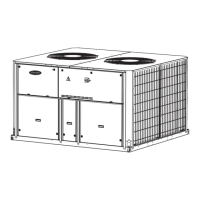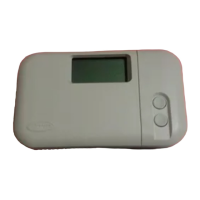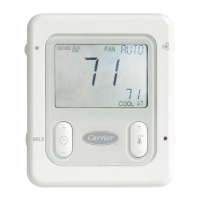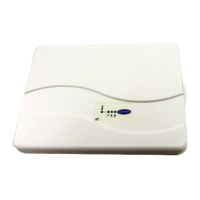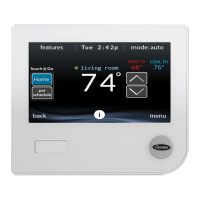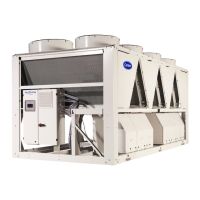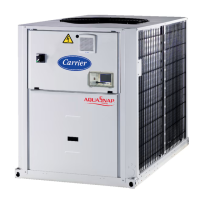O
//
1
Fig. 27 -- Wall Mounted Relative Humidity Sensor
Modulating Baseboard Hydronic Heating -- In-
stall file water valve on the leaving water end of the baseboard
heatel_ See Fig. 30. Observe the fluid flow direction when
mounting the valve. Be sure to properly heat sink the valve and
direct the flmne away from the actuator and valve body when
sweating file valve connections. Install the leaving water tem-
perature sensor (33ZCSENCHG) on the hydi_onic heating coil
as shown. The sensor accommodates nominal copper pipe
fi_om I/2 to l-in. (OD sizes fi_m 5/8 to 1.125 in.). It should be
secured to the pipe with the clamp supplied. If piping is hu_ger
than l-in. nomimfl size, a field-supplied clmnp must be used.
Use fiberglass pipe insulation to insulate the sensor assembly.
Refer to Fig. 7 and 11 to wire the modulating water valve
and the sensor to the zone controllel_ Connect the leaving water
temperature sensor to the controller using the wiring connec-
tions shown for the SAT sensol_ (NOTE: The leaving water
temperature sensor replaces the SAT sensor in this application.)
Use 18 or 20 AWG wire for all connections. The water vfdve
actuator housing may be used as a junction box if the leaving
water temperature sensor cable is not long enough and the
sensor cable must be extended to reach the controllel_
For modulating hydronic heating applications, the default
configuration must be changed to properly control the valve.
Refer to the service configuration table and set the Heating
Loop parameters as follows:
Propollional Gain = 20.0
Integr_d Gtfin = 0.5
Derivative Gain = 0.0
Start Value = 102.0
Also, set the Ducted Heat decision to YES and set the
Maximum Duct Temperature decision equal to the design
(maximum) boiler water temperature minus 20 degrees, but not
greater than 200 E
Connect the Carrier Communicating Net-
work Communication Bus -- The zone controllers
connect to the bus in a &fisy chain mrangement. The zone
controller may be installed on a prim_uy bus or on a secon&tq
bus from the primary bus. Connecting to a secondmy bus is
recommended.
At 9,600 baud, the number of controllers is limited to
128 zones maximum, with a limit of 8 systems (Linkage Coor-
dinator configured for fit least 2 zones). Bus length may not
exceed 4000 ft, with no more than 60 devices on any 1000-ft
section. Optically isolated RS-485 repeaters are required every
1000 ft.
At 19,200 and 38,400 baud, the number of controllers
is limited to 128 maximum, with no limit on the number of
Linkage Coordinators. Bus length may not exceed 1000 ft.
The filet zone controller in a network connects directly to
the bridge and the othel_ are wired sequentially in a daisy chain
fashion. Refer to Fig. 31 for an illustration of Communication
Bus wiring.
The Communication Bus also connects to the zone control-
ler space temperature sensol: Refer to the Install the Sensors
section for sensor wiring instructions.
COMMUNICATION BUS WIRE SPECIFICATIONS -- The
Communication Bus wiring is field-supplied and field-
installed. It consists of shielded three-conductor cable with
&ain (ground) wire. The cable selected must be identical to the
Communication Bus wire used for the entire network. See
Table 2 for recommended cable.
Table 2 -- Recommended Cables
MANUFACTURER CABLE PART NO.
Alpha 2413 or 5463
American A22503
Belden 8772
Columbia 02525
NOTE: Conductors and drain wire must be at least 20 AWG
(American Wire Gage), stranded, and tinned copper. Individual con-
ductors must be insulated with PVC, PVC/nylon, vinyl, Teflon, or
polyethylene. An aluminum/polyester 100% foil shield and an outer
jacket of PVC, PVC/nyIon, chrome vinyl, or Teflon with a minimum
operating temperature range of-20 C to 60 C is required.
CONNECTION TO THE COMMUNICATION BUS
1. Strip the ends of the red, white, and black conductors of
the communication bus cable.
2. Connect one end of the communication bus cable to the
bridge communication port labeled COMM2 (if connect-
ing on a secondary bus).
When connecting the communication bus cable, a color
code system for the entire network is recommended to
simplify installation and checkout. See Table 3 for the
lecommended color code.
3. Connect the other end of the communication bus cable
to the terminal block labeled J2A in the zone controller
of the first air terminal. Following the color code in
Table 3, connect the Red (+) wire to Terminal 1.
Connect the White (ground) wire to Terminal 2.
Connect the Black (-) wire to Terminal 3.
4. Connect additional zone controllers in a daisy chain fash-
ion, following the color coded wiring scheme in Table 3.
Refer to Fig. 31.
NOTE: The communication bus drain wires (shield) must be
tied together at each zone controllel: If the communication bus
is entirely within one building, the lesulting continuous shield
must be connected to ground fit only one single point. If the
communication bus cable exits from one building and enters
another building, connect the shields to ground fit a lightning
suppressor in each building where the cable enters or exits (one
point only).
Table 3 -- Color Code Recommendations
SIGNAL TYPE
+
Ground
COMMUNICATION PLUG PIN
BUS WIRE COLOR NUMBER
Red 1
White 2
Black 3
23

